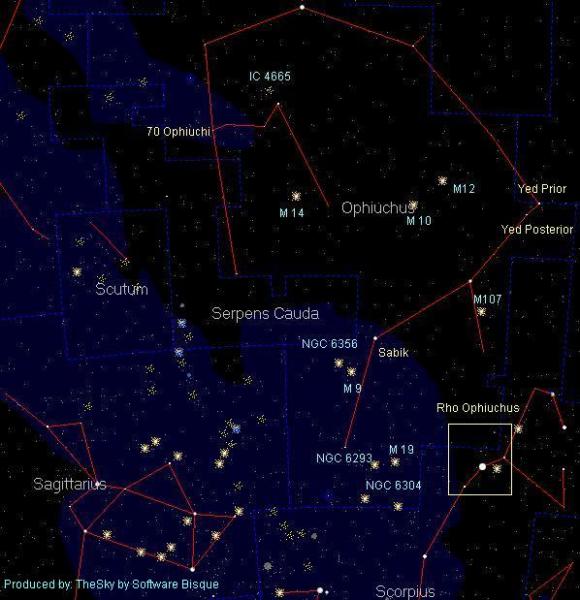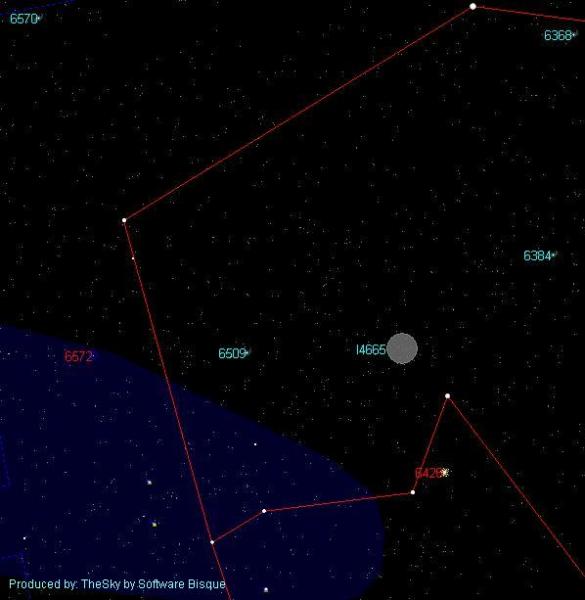Ophiuchus, One Of The Originals
When the astronomer, mathematician and geographer Ptolemy drafted and introduced the original 48 constellations of the night sky to the world, Ophiuchus the Snake Holder made that famous list. Astrology depicts Ophiuchus holding a long snake that actually comprises two constellations – the snake’s head Serpens Caput on the west side and Serpens Cauda, the snake’s tail on the east side.
Not one but two stars symbolize the left hand of the snake holder. They go by the names Yed Prior and Yed Posterior. Even though these two suns are one and a half degrees apart, they mean nothing to each other. Yed Prior lies 170 light-years from us and shines at magnitude 2.8. Prior is an M class star but still has a temperature of 3800 Kelvin. Posterior on the other hand (pardon the pun) sits some 63 light-years closer at 107 light-years and a bit fainter at magnitude 3.3. Both are giant suns but Posterior is living a fast life. When this star came to be, it was a class B but has now powered down to a G9.

Sabik (Eta-Ophiuchi), a pair of third-magnitude class A2 and A3 stars separated by 1.3 arc seconds and is a challenge to split. With a high orbital eccentricity of 0.94, this pair’s does a very close dance from just over 2 astronomical units or closer than the Sun and Mars to 65 astronomical units or twice the Sun-Neptune separation. Sabik is 84 light-years distance.
70-Ophiuchi is another interesting double star. At only 16.7 light-years from us, one can follow its separation from 1.5 arc minutes back in 1989 to 6.8 arc second in the year 2024. The colours of the stars are said to be of yellow and purple. This star system was discovered in 1779 by Sir William Herschel.
Ophiuchus ranks 11th in area and within its 948 square degrees of sky houses an array of wonderful telescopic objects. With this constellation situated close to the Milky Way’s heart, globular clusters rule the sky. Ophiuchus is home to seven Messier objects, all of the globular clusters. A hand full of galaxies also lies within the boundaries.

Of these clusters, M12 is a very high resolved collection of suns. M12 lies 16,000 light-years from us and measures some 75 light-years across itself. Back in 1764, M12 was one of Charles Messier's original finds. Today we know of 13 variable stars that live inside M12. At magnitude 6.7, you will need binoculars to locate it.
M9 is said to be about 5,600 light-years from the Milky Way’s core. From us, however, the distance is more like 26,000 light-years. At 89 light-years across, it is one of the larger clusters. M9 is a full magnitude fainter than M12 but appears smaller.
One of the most beautiful regions to photograph is the lower right section known as the Rho Ophiuchi Nebula Complex Region. It is a colourful collection of a blue reflection nebula, where the gas of dust is lit up by nearby suns. Red emission nebula in which star-forming hydrogen is emitting light and even dark lanes where dust and gas are so thick, only the light of the brightest stars shine through.
The star Rho is located in the blue reflection nebula. Here we see an amazing image taken by Kerry-Ann Lecky Hepburn. Kerry really captured the colour pastels. The beautiful globular cluster M4 also appears to the right of Antares – the heart of the Scorpion. Check out her web site for more incredible images.

Summertime in the northern hemisphere is the best time to observe and photograph Noctilucent clouds. Those living between latitudes 50 and 70 degrees will have a better chance to witness these collections of frozen crystals just after sunset. Noctilucent clouds reside about 80 km above the Earth. At such a high angle, sunlight easily reflects the crystals even when the skies darken.
This month, three planets make near passes to celestial objects thus setting up some lovely Kodak moments. Venus will be one degree above Regulus on July 9. Venus keeps moving up the sky until October when it then begins to sink back west. That is when Venus begins to slide between the Sun and Earth. We will then see its gracious phase structure shrink as the sun’s angle decreases.
On July 21, the planet Saturn will be 10 arc minutes north of NGC 4045 magnitude 11.8. A true telescopic treat that night. Little Mercury swings half a moon width below the star Regulus on July 27. It will be low but still worth a look. The last evening of July will see Mars and Saturn separated by two degrees or four full moons. On the morning of July 8, look for 14% waxing crescent Moon to the left of the Pleiades star cluster low in the east. Jupiter pops above the eastern horizon at on
This month’s full Moon called the Thunder Moon occurs July 25.
Until next month, clear skies everyone.
